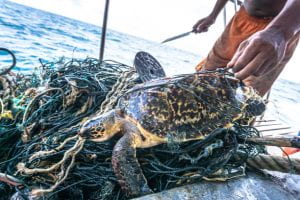Increasing technological advances and consumer demands have taken shopping to a new level. You can now buy clothes, food, and household items from the comfort of your couch, and in a few clicks: add to cart, pay, ship, and confirm. Not only are you limited to products sold in nearby stores, but shipping makes it possible to obtain items internationally. Even social media platforms have shopping features for users, such as Instagram Shopping, Facebook Marketplace, and WhatsApp. Despite its convenience, online shopping has also created an illegal marketplace for wildlife species and products.

Wildlife trafficking is the illegal trading or sale of wildlife species and their products. Elephant ivory, rhinoceros horns, turtle shells, pangolin scales, tiger furs, and shark fins are a few examples of highly sought after wildlife animal products. As social media platforms expand, so does wildlife trafficking.
Wildlife Trafficking Exists on Social Media?

Social media platforms make it easier for people to connect with others internationally. These platforms are great for staying in contact with distant aunts and uncles, but it also creates another method for criminals and traffickers to communicate. It provides a way to remain anonymous without having to meet in-person, which makes it harder for law enforcement to identify a user’s true identity. Even so, can social media platforms be held responsible for making it easier for criminals to commit wildlife trafficking crimes?
Thanks to Section 230 of the Communications Decency Act, the answer is most likely: no.

Section 230 provides broad immunity to websites for content a third-party user posts on the website. Even when a user posts illegal content on a website, the website cannot be held liable for such content. However, there are certain exceptions where websites have no immunity. It includes human and sex trafficking. Although these carve-outs are fairly new, it is clear that there is an interest in protecting people vulnerable to abuse.

So why don’t we apply the same logic to animals? Animals are also a vulnerable population. Many species are unmatched to guns, weapons, traps, and human encroachment on their natural habitats. Similar to children, animals may not have the ability to understand what trafficking is or even the physical strength to fight back. Social media platforms, like Facebook, attempt to combat the online wildlife trade, but its efforts continue to fall short.
How is Social Media Fighting Back?
In 2018, the World Wildlife Fund and 21 tech companies created the Coalition to End Wildlife Trafficking Online. The goal was to reduce illegal trade by 80% by 2020. While it is difficult to measure whether this goal is achievable, some social media platforms have created new policies to help meet this goal.
“We’re delighted to join the coalition to end wildlife trafficking online today. TikTok is a space for creative expression and content promoting wildlife trafficking is strictly prohibited. We look forward to partnering with the coalition and its members as we work together to share intelligence and best-practices to help protect endangered species.”
–Luc Adenot, Global Policy Lead, Illegal Activities & Regulated Goods, TikTok
In 2019, Facebook banned the sale of animals altogether on its platform. But this did not stop users. A 2020 report showed a variety of illegal wildlife was for sale on Facebook. This clearly shows the new policies were ineffective. Furthermore, the report stated:
“29% of pages containing illegal wildlife for sale were found through the ‘Related Pages’ feature.”
This suggests that Facebook’s algorithm purposefully connects users to pages and similar content based on a user’s interest. Algorithms incentivize users to rely and depend on wildlife trafficking content. They will continue to use social media platforms because it does half of the work for them:
-
-
- Facilitating communication
- Connecting users to potential buyers
- Connecting users to other sellers
- Discovering online chat groups
- Discovering online community pages
-
This fails to reduce wildlife trafficking outreach. Instead, it accelerates visibility of this type of content to other users. Does Facebook’s algorithms go beyond Section 230 immunity?

Under these circumstances, Facebook maintains immunity. In Gonzalez v. Google LLC, the court explains how websites are not liable for user content when the website employs content-neutral algorithms. This means that a website did nothing more than program an algorithm to present similar content to a user’s interest. The website did not offer direct encouragement to publish illegal content, nor did it treat the content differently from other user content.
What about when a website profits from illegal posts? Facebook receives a 5% selling fee for each shipment sold by a user. Since illegal wildlife products are rare, these transactions are highly profitable. A pound of ivory can be worth up to $3,300. If a user sells five pounds of ivory from endangered elephants on Facebook, the platform would profit $825 from one transaction. The Facebook Marketplace algorithm is similar to the algorithm based on user interest and engagement. Here, Facebook’s algorithm can push illegal wildlife products to a user who has searched for similar products. Yet, if illegal products are constantly pushed and successful sales are made, Facebook then benefits and makes a profit off these transactions. Does this mean that Section 230 will continue to protect Facebook when it profits from illegal activity?

Evading Detection
Even with Facebook’s prohibited sales policy, users get creative to avoid detection. A simple search of “animals for sale” led me to a public Facebook group. Within 30 seconds of scrolling, I found a user selling live coral, and another user selling an aquarium system with live coral, and live fish. The former reads: Leather $50. However, the picture shows a live coral in a fish tank. Leather identifies the type of coral it is, without saying it’s coral. Even if this was fake coral, a simple Google search shows a piece of fake coral is worth less than $50. If Facebook is failing to prevent users from selling live coral and live fish, it is most likely failing to prevent online wildlife trafficking on its platform.

Another method commonly used to evade detection is when users post a vague description or a photo of an item and include the words “pm me” or “dm me.” These are abbreviations for “private message me” or “direct message me.” It is a quick way to direct interested users to personally reach out to the individual and discuss details in a private chat. It is a way to communicate outside of the leering public eye. Sometimes a user will offer alternative contact methods, such as a personal phone number or an email address. This transitions the interaction off of or to a new social media platform.

Due to high profitability, there are lower stakes when transactions are conducted anonymously online. Social media platforms are great for concealing a user’s identity. Users can use fake names to maintain anonymity behind their computer and phone screen. There are no real consequences for using a fake name when the user is unknown. Nor is there any type of identity verification to truly discover the user’s true identity. Even if a user is banned, the person can create a new account under a different alias. Some users are criminals tied to organized crime syndicates or terrorist groups. Many users operate outside of the United States and are overseas, which makes it difficult to locate them. Thus, social media platforms incentivize criminals to hide among various aliases with little to lose.

Why Are Wildlife Products Popular?
Wildlife products have a high demand for human benefit and use. Common reasons why humans value wildlife products include:
Do We Go After the Traffickers or the Social Media Platform?
Taking down every single wildlife trafficker, and users that facilitate these transactions would be the perfect solution to end wildlife trafficking. Realistically, it’s too difficult to identify these users due to online anonymity and geographical limitations. On the other hand, social media platforms continue to tolerate these illegal activities.
Here, it is clear that Facebook is not doing enough to stop wildlife trafficking. With each sale made on Facebook, Facebook receives a percentage. Section 230 should not protect Facebook when it reaps the benefits of illegal transactions. This takes it a step too far and should open Facebook to the market of: Section 230 liability.
Should Facebook maintain Section 230 immunity when it receives proceeds from illegal wildlife trafficking transactions? Where do we draw the line?


Hi Precious,
Really interesting topic, I had no idea animals were once allowed to be sold and bought on social media marketplaces. That is probably the reason that the algorithm doesn’t show me any of that sort of advertisement.
Speaking of the algorithm, I think it seems to be the common denominator in a lot of issues that we see when evaluating problems with social media. We know the Gonzalez case that the Supreme Court will hear this term highlights this problem. Hopefully, the Supreme Court will recognize the impact a ruling on the transparency of the algorithms has and makes a decision to change the current configuration because you are right, it is not working. Illegal activity should not beget more illegal activity just because someone searched for it once.
I also liked the question you posited about how a financial interest in the sale of goods on their platform should change the level of liability under Section 230. I think you’re right to say that Facebook receiving a percentage of the sale should prevent the company from hiding behind the law and claiming absolute innocence. They are no longer just a publisher when they take a percentage of the sale, no matter how nominal the amount, they now have a real financial interest in the illegal sale that just took place on their platform.
It is clear that the policies put in place by Facebook and the other big companies are not working as well as they should. Unfortunately, I don’t think the companies are going to change dramatically without some sort of legislation to force their hand. It will be incredibly costly and time-consuming to change all of the monitoring methods in place currently, but if Section 230 is amended in a way to increase the level of liability on the big companies, they may be more inclined to spend some time and money to protect their bottom line. We’ll see what happens after this Supreme Court session.
Hi Chris,
I think you’re correct about companies only taking action with some sort of legislation. In that situation, they would be required to make changes, rather than having the option to do so. But with enacting legislation, it would have to gain enough support from the population and legislators. As we learn more about algorithms and how it pushes content to users, people may be willing to support legislation around this issue.
But as you mentioned, we will have to wait and see what happens in the next Supreme Court session. Exciting times!
Precious,
Great work covering a seriously overlooked area of the law when it comes to selling products on social media! This is quite a serious issue and, if we are to take animal rights seriously as a global community, the companies and governments need to act quickly.
Unsurprisingly, the same issues that exist in regards to the sale of other illegal products (drugs, stolen property, etc.) are prevalent here. I think you nailed it on the head when you pointed out that a significant amount of these sales happen in the open on Facebook groups and such with the use of anonymous or fake profiles and vague insider terminology. This angle of the issue requires, in my opinion, significant investment in human teams of investigators by the companies to stay within the current Section 230. While the AI and algorithms of these companies are incredibly powerful, I do not believe that they are strong enough to understand the nuance and insider complexities of such subversive posting. Specifically, I am worried about these technologies overreacting and flagging/banning people for normal, legal, and unrelated use (e.g. when a father took photos of his toddler for medical analysis by a doctor, they auto-uploaded to his Google Drive and were subsequently flagged as child abuse by the algorithm, leading to the freezing of all of his Google products and a police investigation: https://www.theguardian.com/technology/2022/aug/22/google-csam-account-blocked). At this time, only humans alongside technology can interpret these social complexities and tricks of language when targeting these criminals.
In regards to you point about Section 230 not going far enough, I agree! Especially when you consider the profit the companies are making off of it, this lack of legal action is a travesty. Gonzales will have a very interesting impact on this angle of the social media question. The algorithms (and companies) cannot be excused for driving people towards this criminal activity. At best, this is a massive ethical failure of the technologists behind these companies. It is a failure much akin to the resulting political polarization we see today, which can lead to extreme consequences (e.g. Facebook’s alleged role in the Rohingya Genocide https://www.theguardian.com/technology/2021/dec/06/rohingya-sue-facebook-myanmar-genocide-us-uk-legal-action-social-media-violence). Overall, I think we need to go after both the companies and the traffickers.
My only critique against your otherwise stellar post is that, when considering any criminal activity, we need to consider the economic incentives driving such trafficking. As we have learned from the War on Drugs, policing alone does not kill the demand for illegal products; the financial and social pressure to jump on this economic opportunity is incredibly strong, so like the mythical Lernaean Hyrda of Greek mythology, when the government or companies cut off one path of this criminal activity, two more will replace it. This is especially true when you consider that many of these animal products are coming from developing states and, arguably, the most of the poachers (and perhaps some of the traffickers) are operating in this illegal market due to economic desperation. While there are certainly people acting in pure self-interest or economic expedience, and while impoverishment does not broadly excuse crime, if governments do not address this animal trafficking problem with the economic incentive in mind, alongside public education, legal enforcement against companies, and policing, we will find ourselves stuck in an endless policing cycle that, at the end of the day, hurts the animals the most.
Nevertheless, excellent work as always!
Thanks,
Alex G